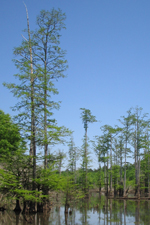Wetland Ecology

Photo courtesy Jennifer Key,
TPWD 2004, Angelina County
Wetlands, which are fluctuating ecosystems inherently difficult to categorize, are often found at the intersection of terrestrial habitat and aquatic habitat and usually include elements of both systems. Many wetlands are unique to a certain degree, as their individual characteristics are determined by a combination of factors such as climate, soils, hydrology, and vegetation.
One of the most important factors that determines the overall nature of a wetland however, is hydrology, since the timing, quantity, and duration of water flow strongly influences both abiotic and biotic factors within a wetland. Abiotic factors that are determined by hydrology in a wetland could include soil texture, water quality, or topography, whereas biotic factors influenced by hydrology in a wetland would be plant and animal types, diversity, or quantity. Of course, hydrology doesn't always affect biology, as animals such as beavers can change the nature of a stream by constructing a dam, or vegetation can build up over time in an area and reduce available surface water through increasing evapotranspiration.
Most wetlands experience a fluctuating water level on a seasonal or even yearly
basis, so some areas that are difficult to identify as wetlands during the
summer may be completely inundated during the winter. Texas contains several
different types of wetlands, each of which offers a varying degree
of wetland functions and values, including providing habitat for wildlife.